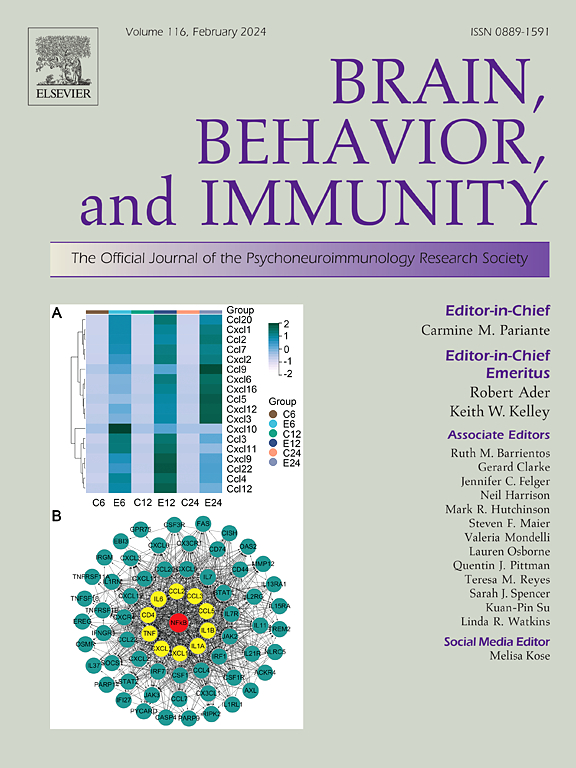Demyelination of the amygdala mediates psychological stress-induced emotional disorders partially contributed by activation of P2X7R/NLRP3 cascade
IF 8.8
2区 医学
Q1 IMMUNOLOGY
引用次数: 0
Abstract
Psychological stress can lead to emotional disorders, such as anxiety and depression; however, the underlying mechanisms are complicated and remain unclear. In this study, we established a mouse psychological stress model using an improved communication box, in which the psychologically stressed mice received visual, auditory, and olfactory emotional stimuli from the mice receiving electric foot shock, thus avoiding physical stress interference. After the 14-day psychological stress paradigm, our mice exhibited a significant increase in depressive and anxious behaviors. We then performed proteomic liquid chromatography–tandem mass spectrometry for proteomic data analysis of the amygdala, and the results demonstrated that differentially expressed proteins were more enriched in myelin-related biological processes, cellular components, and molecular functions, indicating a correlation between psychological stress–induced emotional disorders and amygdala myelin damage. Molecular and morphological evidence further confirmed that psychological stress damages myelin ultrastructure, downregulated myelin basic protein and proteolipid protein expression, and reduced oligodendrocyte proliferation in the amygdala. Moreover, clemastine, an antimuscarinic and antihistaminic compound that has been shown to enhance oligodendrocyte differentiation and myelination, rescued depressive behaviors accompanied by increased oligodendrogenesis. In the amygdala, psychological stress was also noted to activate microglia and increase the levels of NOD-like receptor protein 3 (NLRP3) and the proinflammatory cytokines interleukin 1β and tumor necrosis factor α, as indicated by ELISA and Western blot analyses. Moreover, in stressed mice, the administration of Brilliant Blue G, a purinergic ligand-gated ion channel 7 receptor (P2X7R) antagonist, completely reversed the increases in NLRP3 and cleaved caspase-1 levels and partially prevented amygdala myelin damage. In conclusion, amygdala demyelination may mediate psychological stress–induced emotional disorders, and P2X7R/NLRP3 cascade activation partially contributes to amygdala myelin damage after psychological stress.
杏仁核脱髓鞘在一定程度上通过激活 P2X7R/NLRP3 级联介导了心理压力引起的情绪失调。
心理压力会导致情绪障碍,如焦虑和抑郁;然而,潜在的机制是复杂的,仍然不清楚。本研究采用改进的通讯箱建立小鼠心理应激模型,心理应激小鼠接受足电小鼠的视觉、听觉和嗅觉情绪刺激,避免物理应激干扰。经过14天的心理应激模式后,我们的小鼠表现出抑郁和焦虑行为的显著增加。然后,我们对杏仁核的蛋白质组学数据进行了蛋白质组学液相色谱-串联质谱分析,结果表明差异表达的蛋白质在髓磷脂相关的生物过程、细胞成分和分子功能中更丰富,表明心理应激诱导的情绪障碍与杏仁核髓磷脂损伤之间存在相关性。分子和形态学证据进一步证实,心理应激损伤髓鞘超微结构,下调髓鞘碱性蛋白和蛋白脂蛋白表达,减少杏仁核少突胶质细胞增殖。此外,clemastine,一种抗蛇毒碱和抗组胺化合物,已被证明可以促进少突胶质细胞分化和髓鞘形成,挽救伴随少突胶质形成增加的抑郁行为。ELISA和Western blot分析显示,在杏仁核中,心理应激也可以激活小胶质细胞,增加nod样受体蛋白3 (NLRP3)和促炎细胞因子白介素1β和肿瘤坏死因子α的水平。此外,在应激小鼠中,给予嘌呤能配体门控制离子通道7受体(P2X7R)拮抗剂Brilliant Blue G,完全逆转了NLRP3和caspase-1水平的升高,并部分预防了杏仁核髓磷脂损伤。综上所述,杏仁核脱髓鞘可能介导心理应激性情绪障碍,P2X7R/NLRP3级联激活在一定程度上参与了心理应激后杏仁核髓磷脂损伤。
本文章由计算机程序翻译,如有差异,请以英文原文为准。
求助全文
约1分钟内获得全文
求助全文
来源期刊
CiteScore
29.60
自引率
2.00%
发文量
290
审稿时长
28 days
期刊介绍:
Established in 1987, Brain, Behavior, and Immunity proudly serves as the official journal of the Psychoneuroimmunology Research Society (PNIRS). This pioneering journal is dedicated to publishing peer-reviewed basic, experimental, and clinical studies that explore the intricate interactions among behavioral, neural, endocrine, and immune systems in both humans and animals.
As an international and interdisciplinary platform, Brain, Behavior, and Immunity focuses on original research spanning neuroscience, immunology, integrative physiology, behavioral biology, psychiatry, psychology, and clinical medicine. The journal is inclusive of research conducted at various levels, including molecular, cellular, social, and whole organism perspectives. With a commitment to efficiency, the journal facilitates online submission and review, ensuring timely publication of experimental results. Manuscripts typically undergo peer review and are returned to authors within 30 days of submission. It's worth noting that Brain, Behavior, and Immunity, published eight times a year, does not impose submission fees or page charges, fostering an open and accessible platform for scientific discourse.

 求助内容:
求助内容: 应助结果提醒方式:
应助结果提醒方式:


